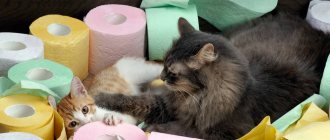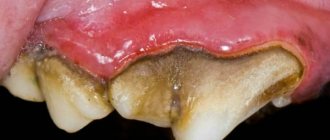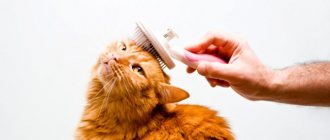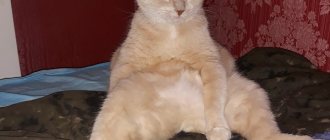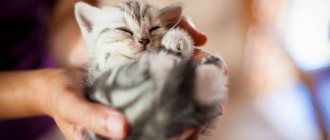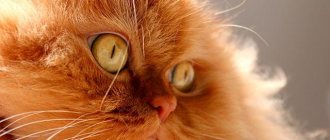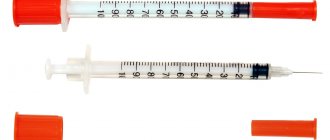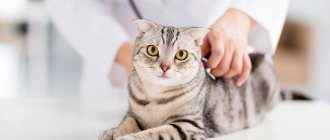Cats are often constipated. It is usually mild and you can help your cat with simple home remedies.
But sometimes constipation in cats can indicate a more serious health problem, and it can become very serious and unpleasant. So how do you know if it's a serious problem that requires your veterinarian's attention?
Here's what you need to know about the symptoms and causes of constipation in cats, what you can do to help your cat, and when to worry.
Symptoms of constipation in cats
Constipation is characterized by infrequent or difficult bowel movements. Most cats poop every 24-36 hours. If your cat poops less frequently and has difficulty pooping, she may be constipated.
Although there are some normal variations, if more than 48-72 hours have passed without a bowel movement, you should contact your veterinarian.
The main sign of constipation in cats is dry, hard stool (either inside or outside the litter box)
Feces are usually a deep brown color and should appear well formed.
Healthy stool has enough moisture for debris to stick to it. Cats with constipation may have very dry and hard stools.
You may find these poops outside the litter box because the discomfort associated with attempting to defecate can cause cats to leave the litter box before they are actually finished. You may also notice the cat crying or straining in the litter box, or avoiding the litter box altogether.
Other signs of discomfort may include sounds or straining when using the litter box or having to go in and out several times before using it.
Your cat may strain, but may not poop at all. Discomfort in the litter box can also be a sign of serious urinary tract problems, so you should contact your veterinarian if you notice these signs.
Constipation is actually a symptom of other problems, so you may also see signs of an underlying cause.
These may include:
- Nausea
- Decreased appetite
- Vomiting
- Drinks more or less water
- Pissing more
- Weight loss
- Loss of muscle mass
- Difficulty of bouncing
- Stiff walking
- The cat is hiding
If you experience any of these symptoms with or without constipation, you should discuss them with your cat's veterinarian.
Clinical symptoms
Before deciding what to do with a kitten in the first weeks of life, at 1 month, or with an older cat, you need to make sure that he really is constipated. After all, sometimes defecation once every 2-3 days can simply be a feature of the body.
Some tips on how to tell if your kitten is constipated:
- The baby doesn't go to the toilet for three days. Sometimes he has difficulty squeezing out some hard and dry feces in the form of small peas.
- The kitten sits in the tray for a long time in the appropriate position, as it cannot empty its intestines and meows loudly. The feces contain blood and mucus.
- The small pet becomes passive and apathetic and periodically makes alarming sounds. His appetite disappears or decreases. Vomiting (or frequent urge to do so) often occurs.
- The kitten's tummy becomes enlarged and tense. Touching it causes pain or discomfort in the baby.
If the pet is not helped in time, he begins to lose weight and experience fear of the litter box. The most serious consequences are intoxication of the body, intestinal ruptures and even death.
Causes of constipation in cats
Anything that causes dehydration in a cat can cause constipation. Some problems are mild and can be treated at home with diet and lifestyle changes, while some can be serious.
Constipation can occur when the bowels do not move normally, causing the stool to remain soft and moist. Constipation can be caused by things like stress and anxiety, inflammatory bowel disease, allergies, nerve disorders, and even some types of cancer.
Chronic conditions that can lead to constipation in cats include kidney disease, diabetes, and hyperthyroidism. Torn or damaged anal sacs can also cause your cat pain when defecating and lead to constipation. Cats that eat dry food are also prone to dehydration and constipation.
If your cat holds stool for longer than usual, constipation may occur as the intestines reabsorb too much water when stool sits in them for too long.
Reasons for this include obesity, stress and anxiety, pain from arthritis or anal gland problems, blockage or even some types of cancer.
Can complications occur?
One of the serious consequences of not treating constipation in a kitten is the transition of the disease to the chronic stage. This means that your pet will continue to have problems with bowel movements in the future: for example, from time to time he may have difficulty going to the toilet or his intestines will be partially emptied. This means that intoxication of the body will continue. Its manifestation is a noticeable decrease in activity, appetite and weight and frequent nausea.
Veterinary treatment of constipation in cats
Constipation is common in cats, but can indicate a serious medical condition and should be discussed with your veterinarian.
Constipation should be treated as soon as possible to reduce the risk of permanent damage due to prolonged distension of the colon. Effective treatment includes identifying and correcting the underlying condition (if possible), removing affected feces, and preventing recurrences.
For immediate relief of constipation, your veterinarian may give your cat fluids and/or an enema. Giving a cat an enema is a veterinary job and should not be attempted at home. Some types of enemas intended for humans are actually very toxic to cats.
Veterinarians may also prescribe medications or recommend over-the-counter medications to help manage your cat's constipation symptoms.
More importantly, your veterinarian can help identify the underlying problem causing constipation so it can be treated rather than just trying to manage the symptoms.
Some cats with long-term constipation may have megacolon, an enlarged intestine caused by a defect in the muscle strength of the colon. Cats with chronic constipation or megacolon that do not respond to treatment may respond to removal of the affected area of the colon.
Group of bulk-forming drugs
Preparations in this group can be of plant or artificial origin. The most well-known representatives are Metamucil or flaxseed-based medications.
- All active components act in the intestinal lumen without being absorbed into the bloodstream.
- In the large intestine, the components of the drug actively accumulate water and dilute the pet’s stool.
- Due to greater pressure on the rectal sphincter, the act of defecation is stimulated.
Indications for the use of drugs include chronic constipation, exacerbation of hemorrhoids, anal fissures, functional constipation during cat pregnancy.
Home Remedies for Constipation in Cats
Here is a list of things you can do at home to relieve your cat's constipation.
Increase your water consumption
Since dehydration contributes to constipation, drinking more water and staying well hydrated helps prevent constipation.
Cats do not drink standing water very well, so the best way to increase their water intake and keep them hydrated is to feed them wet food. This significantly increases your water intake and significantly reduces the risk of constipation.
You can also encourage your cat to drink more water by placing more bowls in different parts of your home, trying pet water fountains, letting the faucet drip, and adding additives to the water that cats like, such as clam juice, tuna juice, or beef juice. bouillon.
If you flavor your cat's water, always leave a plain source of water in case she doesn't like flavored water.
Try a new diet
Food allergies can cause intestinal inflammation and constipation in cats. Changing the source of protein in your cat's food (chicken, lamb, etc.) can reduce inflammation and allow the bowels to move more normally, reducing constipation.
Special limited ingredient and hypoallergenic diets are also available for cats that may be allergic to multiple things. However, it takes about 8-12 weeks for a diet change to work, so it is part of long-term treatment.
Follow the recommended transition period by mixing old food with new food as directed on the cat food package.
Help your cat maintain a healthy weight
Obesity causes intestinal inflammation, which slows down bowel function. Too much water is then absorbed through the stool, causing constipation. In severe cases, there is so much fat in the abdomen that it physically makes it difficult for stool to move.
Your veterinarian can help you figure out whether your cat needs to lose weight and work with you to come up with a diet plan.
Increased exercise and enrichment
Exercise promotes normal bowel movement, which helps treat and prevent constipation.
Encourage your cat to be more active with things like cat toys, cat trees, window seats, and more time to play with you. Exercise will also help keep your cat enriched and reduce his anxiety, as well as help him lose weight.
Minimize stress and anxiety
Cats can become stressed easily if their daily routine is disrupted. This could be a more obvious reason, such as adding a new pet to the house or moving, or a less obvious reason, such as a change in your schedule, construction noise nearby, or a new dog barking in the neighborhood.
Sometimes a cat just needs time to adjust to changes. But you can help reduce stress and anxiety by using calming pheromones (Feliway), supplements (Zylkene and Solliquin are commonly used), herbs and/or medications.
Add more trays
Cats are very picky about their litter boxes. If they don't like the placement of the litter box or even the type of litter box or litter, they may not use it as often, which can lead to constipation.
You should have at least one more litter box than cats, and there should be at least one litter box on every floor of your home.
You may need to experiment with different types of crates and litter to find what your cat likes.
Try fiber or probiotics
Probiotics are “good bacteria” that help support gut health. A healthy bowel will move stool normally and keep it soft, preventing constipation.
Fiber feeds beneficial bacteria and promotes normal bowel movement. It also helps retain more water in the intestines, which helps treat and prevent constipation.
There are different types of fiber, so what works best will depend on the cats. Some common sources are psyllium husk (Metamucil) and wheat bran.
Canned pumpkin is often used, but it actually contains very little fiber and a lot of sugar, so it's not a good choice for most cats.
However, cats have a slightly different gastrointestinal tract than humans, so a high-fiber diet may not always help with constipation.
In fact, sometimes a low-fiber diet works better. This largely depends on the cause of the problem. It is important to understand that there is usually an underlying cause for constipation, and your cat should be taken to a veterinarian to help determine it.
Ask your veterinarian about over-the-counter laxatives
The following over-the-counter products may treat symptoms of constipation, but be sure to consult with your veterinarian before giving your cat any new supplements or medications.
There are several types of laxatives that work in different ways. Most over-the-counter medications cause the body to pull more water into the intestines, which helps soften the stool and make it easier to pass.
Because they draw water into the intestines, laxatives can worsen other symptoms in cats with chronic illnesses by causing dehydration. You should ask your veterinarian if they are suitable for your cat.
Miralax (PEG 3350) is commonly used in cats with constipation, and Colace (docusate) can also be used. Other laxatives intended for humans may cause problems in cats.
Oil- or fat-based laxatives, such as laxatone, should only be used if recommended by a veterinarian and should not be used long-term as they may affect your cat's ability to absorb nutrients from food.
Monitor your cat for constipation
Monitor your cat's bowel frequency and stool consistency at least twice a week initially, and then weekly or biweekly.
Contact your veterinarian if you notice very hard, dry feces or if you notice your cat straining during bowel movements.
Watch for any other signs of constipation and contact your veterinarian if you notice diarrhea, especially since it can quickly lead to dehydration.
Methods for solving the problem
If problems with constipation are so serious that your pet is already meowing pitifully, vomiting, or lying down exhausted, you should immediately consult a veterinarian. He will conduct the necessary examinations, give the animal an enema, a drip to eliminate dehydration, and possibly carry out other medical procedures. When everything is not so scary, you can fight the causes and symptoms of a cat’s intestinal obstruction at home.
Balance your diet
Modern fluffies often fall victim to the busyness of their owners, who give them industrially produced food - dry or canned. In both cases, food is not able to replace the classic mouse with its protein muscles, plant debris in the stomach and hair with bones. Store-bought food is high in carbohydrates (dry), low in fiber and dietary fiber (canned), and low in vitamins. Food from the master's table, transferred to the cat's bowl, does not save the situation.
Therefore, if a cat has constipation, we recommend saturating his menu with natural raw proteins, living vitamins (sprouted oats on the windowsill) and dietary fiber. This is grated raw carrots, pumpkin, cabbage, zucchini or bran. Cereals, such as oatmeal, are suitable as a base for soups or porridges. Don’t forget to also pamper your pet with yogurt and kefir from time to time.
Look after the fur
The accumulation of hair in the intestines is a problem that is typical primarily for long-haired cats. If your cat doesn't eat plant fibers, it can lead to constipation. Caring owners comb such pets daily, during the molting period - up to two or three times a day. Also, to remove hair as a preventive measure, it is necessary to give a special paste, for example, Cliny or Malt-Soft.
The easiest way to help your cat remove the fur that has already entered the intestines is to sow wheat, oats or rye on the windowsill. As soon as the grass comes up, it will purr - rest assured! - will begin to graze on it, thereby preventing problems with stool.
Give laxatives
If your cat has not been able to go to the litter box for several days, treat her with a mild laxative. It could be kefir, condensed milk half and half with water. Some people add a few drops of vegetable oil to the food.
Do an enema
When preventive measures have not given a positive result and the cat cannot go to the toilet, you will have to give him an enema with boiled water cooled to room temperature. You can add potassium permanganate or Vaseline oil there. This method, of course, is nerve-wracking - both for you and for the animal - but when carried out correctly it immediately provides relief. Since there is a danger of injuring the purr during an enema, it is better to consult a veterinarian.
A little about prevention
If a kitten is constipated often, what should you do?
Frequent problems with big hikes require some preventive measures. Make sure to provide your animal with the proper diet. It must necessarily include fiber, which can be found in sufficient quantities in bran, cereals and vegetables. Some cases involve the introduction of dairy and fermented milk products into the diet on an ongoing basis. Periodic use of Vaseline oil in small quantities helps to facilitate the process of defecation and avoid injury to the walls of the rectum.
It is important to remember about wool. Veterinarians recommend giving long-haired cats special preparations for rutting fur as part of prevention.
Give the kitten more opportunity and space to run and play, which will have a beneficial effect not only on the functioning of the gastrointestinal tract, but also on the general well-being of the little family member.
Carefully following these rules will ensure your baby a healthy, long and happy life.
